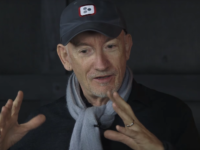As I started to think about what I wanted to say about the retirement of Hayao Miyazaki, my mind fell rather clumsily on the disputed quote said to about Alexander the Great about having “no more worlds to conquer.”
But the gentle soul of the 72-year-old animator, director, writer, and artist had no interest in conquering worlds, only nurturing them, so the quote slipped from the page as quickly as it made its way on.
Indeed, the co-founder of Studio Ghibli — Japan’s storied animation film studio — leaves a legacy of worlds of enchantment, invigoration and calm across a landscape of animated features that usually relies on cheap tricks and busy nonsense to distract rather than engage and transport audiences.
The pictures of Miyazaki are deeply human and deeply humane, opening universes that abhor the sorts of violence and easy villain-making of much modern storytelling. His concerns about the environment are evident in the lush landscapes and choking machinery, while his respect for children and young people can be found in every complex line and realistic answer.
The worlds of Miyazaki tell us what we need to know about one of the world’s finest directors and artists.
His debut came in 1979 with Lupin III: The Castle of Cagliostro. An adaptation of a manga and the second film in a series, this is not among Miyazaki’s best known — or finest — hours. It is an indication of greatness to come, however.
Where he really dug his heels in was with the 1984 film Nausicaä of the Valley of the Wind. For this world, Miyazaki explored the post-industrial realm. The picture takes place 1,000 years after the Seven Years of Fire, a catastrophic event that wiped out most of our world’s ecosystem. Miyazaki’s environmental concerns are presented unadorned and his hope for the future is represented by the titular princess, a multi-dimensional heroine who both commands respect and inspires calm.
Laputa: Castle in the Sky follows as a reworking of Gulliver’s Travels of sorts. This 1986 film takes place in the fictional realm of Laputa, a floating city that has uses for the pirates pursuing its gold and the military pursuing its potential as a weapon. The filmmaker wisely sidesteps politics with the characters of Sheeta and Pazu, too, which makes the message more universal.
1988’s My Neighbor Totoro is one of my personal favorites and one of the most impactful films of Miyazaki’s career. It took place in postwar Japan, using a rural setting to unlock the imagination of Mei in her hour of need. She allows the figure of Totoro to embody her ill mother, but she still exists in a world of kindness even with the potential environmental pressures.
Kiki’s Delivery Service introduces a more European world, with Miyazaki noting that he used a Swedish city as inspiration. This 1989 film is about the pressures faced by teenaged girls, so placing it in an almost idealistic setting makes for some unique challenges. There are no villains hiding behind the shops, but there is pragmatic trouble way up high on the broomstick.
Miyazaki’s Porco Rosso deals with the “Crimson Pig,” a porker who now makes a living chasing pirates in the Adriatic Sea. The world here is somewhat isolated yet it functions under its own rules, with Porco moving through a post-World War I universe. This is one of the rare pictures for Miyazaki where the “real world” is as it is; there are no attempts to disguise the locale as some other place, so its grounding in reality is vital.
The masterful Princess Mononoke is often cited as Miyazaki’s masterpiece. A period drama of sorts from the Muromachi period in Japanese history, this 1997 picture is a glorious fantasy and also one of his darkest works. There are outcasts in Miyazaki’s Iron Town and there is hatred in the air, with the incessant conflict between the industrial world and the natural world serving as the foundation for high drama.
Spirited Away is Miyazaki’s most successful movie. It won an Oscar and has gathered acclaim internationally for its tale of childhood and imagination. The 2001 feature deals with a very, very animated bathhouse. Inspiration for the tale came from a bathhouse that was in Miyazaki’s hometown, with the mysteries behind those closed doors leading to some pretty remarkable, pretty funny stories.
2004’s Howl’s Moving Castle takes its inspiration from architecture in France, namely in the region of Alsace. The futuristic vision of French illustrator Albert Robida is also apparent, while the violence of the Iraq War also clearly holds influence on the picture. Miyazaki’s distaste for all violence and war shows up in every glowing frame of the movie.
Ponyo, Miyazaki’s 2008 film, is another wonderful vision in a wonderful world. This picture deals with the sea as inspiration and takes some of its storytelling ideas from Hans Christian Andersen’s The Little Mermaid. The filmmaker’s affection for the ocean’s waves went so far as to drive him to hand-draw the sea himself, which eventually led to over 170,000 separate images.
Miyazaki’s last feature, The Wind Rises, will see a North American release in November of 2013.
The director was also heavily involved in several other features for Studio Ghibli, having written bits and pieces for films like Whisper of the Heart and The Secret World of Arietty. Throughout each feature and each penned detail, his affection for the universes he nurtures is clear.
The retirement of Hayao Miyazaki signals the end of an era in animated film for certain, but his legacy lives on in his remarkable body of work and, better still, his ethics as evident in his creations.
“I wanted to convey the message to children that this life is worth living,” he said upon announcing his retirement. “This message has not changed.”
[amazon_enhanced asin=”B004CRR9G0″ container=”” container_class=”” price=”All” background_color=”FFFFFF” link_color=”000000″ text_color=”0000FF” /] [amazon_enhanced asin=”B007JNTOBC” container=”” container_class=”” price=”All” background_color=”FFFFFF” link_color=”000000″ text_color=”0000FF” /] [amazon_enhanced asin=”B002ZTQV8Y” container=”” container_class=”” price=”All” background_color=”FFFFFF” link_color=”000000″ text_color=”0000FF” /] [amazon_enhanced asin=”B000FGG5NK” container=”” container_class=”” price=”All” background_color=”FFFFFF” link_color=”000000″ text_color=”0000FF” /] [amazon_enhanced asin=”B00005JLEU” container=”” container_class=”” price=”All” background_color=”FFFFFF” link_color=”000000″ text_color=”0000FF” /]
- The Black Keys Pushed Forward Without Losing Their Way on ‘Turn Blue’ - May 12, 2019
- David Ian’s ‘Valentine’s Day’ Made Romance Romantic Again - February 14, 2019
- Jerry Kalaf – Welcome to Earth (2015) - February 6, 2015




